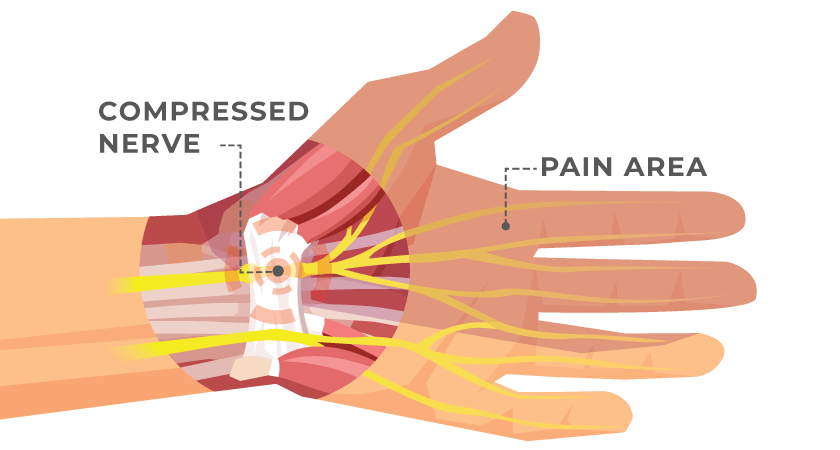
Stop the Pain and Tingling: Manage Peripheral Neuropathy with Chiropractic
Pressure on nerves can cause pain, numbness, and tingling. If you’re living with neuropathy in your hands, feet, arms or legs, this post is for you.

When most people think about seeing a chiropractor, it’s usually for back pain or neck pain. But seeing a chiropractor for carpal tunnel? You bet. Here’s why.
From brushing your teeth in the morning to that first sip of coffee or tea, right up until the moment you set your alarm and finally climb into bed, if you are living with carpal tunnel syndrome, the symptoms are likely affecting just about every part of your day.
Carpal Tunnel Syndrome can make it difficult to do the things that make up your day, from driving to cooking, holding your kids, or even carrying your handbag or groceries. For those who use a computer all day, perform work that requires force, repetitive movements, or the use of high pressure or vibrating equipment, there is not only an increased risk of Carpal Tunnel Syndrome; the symptoms of CTS can be especially difficult to live with, manage, or treat.
If you’re considering whether to see a chiropractor for carpal tunnel syndrome pain, here’s what you need to know.
Carpal Tunnel Syndrome (CTS) affects up to 5% of the general population. Located on the palm side of your hand, the carpal tunnel is a narrow passageway surrounded by bones and ligaments. Carpal tunnel syndrome is the result of pressure on the median nerve which runs through the carpal tunnel.

Symptoms of Carpal Tunnel can vary between people but one thing they have in common is that in most cases, symptoms start slowly and gradually worsen as the condition progresses.
The most common symptoms of CTS include:
The causes of CTS are varied, and in some cases, there are multiple factors which contribute to CTS. Carpal tunnel syndrome most commonly results from problems in the anatomy of the wrist, health problems, or repetitive hand motions which put pressure on the median nerve which runs through the carpal tunnel.
Other causes include:
Accidents & Injuries. A fracture or dislocation in the wrist can deform the wrist bones, altering the space within the carpal tunnel and compressing the nerve within.
Anatomic Factors. People who naturally have smaller carpal tunnels may be at greater risk of CTS.
Biological Sex. Women are at greater risk of CTS than men, possibly because the carpal tunnel area is smaller in women, and also because conditions like pregnancy can trigger CTS.
Nerve-damaging Conditions. Some chronic illnesses, such as diabetes, increase the risk of nerve damage, including damage to the median nerve which causes carpal tunnel pain.
Inflammatory Conditions. Rheumatoid arthritis and other inflammatory conditions can affect the lining around the tendons in the wrist.
Other Medical Conditions. Medical conditions including thyroid disorders, kidney failure and lymphedema, can increase the risk of carpal tunnel syndrome.
Medications. Research has indicated a link between carpal tunnel syndrome and the use of specific cancer treatment drugs.
Pregnancy & Menopause. Fluid retention is common during pregnancy and menopause. This can cause swelling that may increase pressure within the carpal tunnel, irritating the median nerve.
If treated early, CTS can be reversed. Left untreated, the nerve damage can become permanent.
Treatment options for CTS include:
Carpal Tunnel Syndrome and Thoracic Outlet Syndrome share many of the same symptoms, but they are different conditions, each with a root cause that lies in different parts of the body.
Unlike CTS, which begins in the wrist, Thoracic Outlet Syndrome (TOS) affects the nerves between your collar bone and your first rib. It is commonly caused by physical trauma, anatomical defects (such as an extra rib), or by pregnancy. Diagnosing TOS can be difficult, especially as a root cause is not always clear. That’s why it’s important to see a doctor if you’re experiencing symptoms of TOS or CTS, and to have a confirmed diagnosis before seeking treatment.

Symptoms of TOS include:
*indicates symptoms not associated with Carpal Tunnel Syndrome
Some factors, like medical conditions, pregnancy, or medication use, can make CTS difficult to predict – or prevent. However, even for those at higher risk for CTS, including those who perform repetitive tasks as part of their jobs, there are steps they can take to minimize risk.

Let it go. Relax your grip when holding your phone, steering wheel, and even when holding a pen or pencil. Be gentle when texting or tapping the keys on your laptop or phone.
Take 5. Short, frequent breaks to gently stretch and bend the hands and wrists can relieve pressure. They’re especially important if your routine puts you at higher risk of CTS.
Set yourself up for success. Use good ergonomics when driving, at work, and when sitting at a desk.
Stand (and sit) up straight. Poor posture affects the whole body – wrists included. Slouching shortens the neck and shoulder muscles, compressing the nerves in your neck, which can affect the wrists, fingers and hands.
Warm things up. Hand pain and stiffness is more common when working in a cold environment.
While these methods won’t reverse Carpal Tunnel Syndrome, they can support your gentle chiropractic adjustments and help you find relief from your symptoms.
Ready for relief from your Carpal Tunnel Syndrome pain? Find a Chiro One clinic near you.
Subscribe and get news, articles & offers sent right to your inbox each month.
"*" indicates required fields
By subscribing you are agreeing to the Terms and Conditions and Privacy Policy.